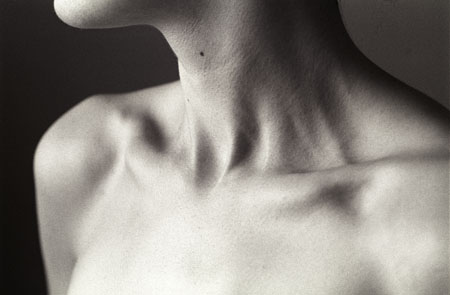Successful images can be created while excluding part of the subject's face, or even the head and shoulders. There is no absolute requirement for the subject to be recognizable. Evocative images can also be obtained by concentrating on small parts of the body.
 To do this sort of work it is necessary for a photographer to be very close to the subject. Since portraiture lenses commonly have a minimum focused distance of about 50-80cms, and a maximum reproduction ratio of perhaps 1:8, some type of close-up lens or accessory must be used. Supplementary close-up lenses, bellows and extension rings all allow closer approach to the subject and larger reproduction ratios, but a micro lens gives the highest image quality. Lenses of this type are designed specifically for close-up work. They focus down to about 20 or 30cms and can normally achieve reproduction ratios of 1:2 or 1:1. This means that the subject can be reproduced at near life size on film.
To do this sort of work it is necessary for a photographer to be very close to the subject. Since portraiture lenses commonly have a minimum focused distance of about 50-80cms, and a maximum reproduction ratio of perhaps 1:8, some type of close-up lens or accessory must be used. Supplementary close-up lenses, bellows and extension rings all allow closer approach to the subject and larger reproduction ratios, but a micro lens gives the highest image quality. Lenses of this type are designed specifically for close-up work. They focus down to about 20 or 30cms and can normally achieve reproduction ratios of 1:2 or 1:1. This means that the subject can be reproduced at near life size on film.
A Micro-Nikkor 105mm f2.8 lens, for example, also serves in a normal short telephoto role, but whatever the solution depth of field will be an issue. Use a tripod to keep the camera stable, and select a slow shutter speed. This reduces aperture as far as possible, perhaps to f/22 or even f/32, and maximizes depth of field. Ask models to momentarily hold their breath when using shutter speeds slower than about 1/15second, and remember that reciprocity characteristics may become a consideration when exposing film for more than one second.
Using a camera so close to somebody is a personal business. You are well within personal space, the invisible area of privacy that surrounds every human being, and an inexperienced subject may feel uncomfortable. Spend some time explaining what is intended. This helps the model to relax and understand what results to expect. The images can be quite powerful because perspective is accentuated under such circumstances. The impact is even greater when the images are enlarged and printed since parts of the body may then be magnified to many times life size.






